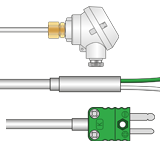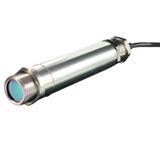What is a Temperature Probe?
A temperature probe is a specialised device used for measuring and monitoring the temperature of fluids, gases and surfaces in various environments across industry. They are designed to accurately sense and convert thermal energy into a readable signal, providing information about temperature changes in a specific location or substance.
These probes come in various types, each using a different method to measure temperature variations. Common types of temperature probe include thermocouples, resistance temperature detectors (RTDs) like Pt100 sensors, thermistors, and infrared thermometers. They differ in the way they measure the temperature, the operating range they cover, their accuracy, and their suitability for different applications.
Typically, a temperature probe consists of a sensing element that reacts to temperature changes, housed within a protective sheath to shield it from external factors such as moisture, chemicals, or physical damage. They often feature connectors or interfaces like transmitters for integration with temperature measuring instruments, data loggers, or control systems, enabling real-time monitoring and analysis of temperature data.
These temperature probes find wide application uses across many industries, such as healthcare, food processing, manufacturing, aerospace, and scientific research. They are crucial for maintaining optimal conditions, ensuring product quality, safety, and efficient operation within different processes and environments.
Types of Temperature Probe
Thermocouples
These probes rely on the principle of a thermoelectric effect, generating a small voltage which is proportional to temperature differences at the junction of two dissimilar metals. They are well suited to extreme temperatures and harsh environments due to their robustness and versatility. Find out more about how a thermocouple works.
RTDs (Resistance Temperature Detectors)
Usually Pt100, these sensors make use of the resistance vs. temperature relationship of platinum. As temperature changes, the sensor's resistance changes proportionately, providing highly accurate and stable readings within defined temperature ranges. Find out more about how an RTD works.
Thermistors
These sensors also rely on a change in electrical resistance with temperature variations. Thermistors are highly sensitive to temperature changes, but have a limited temperature range compared to other probes.
Infrared Thermometers
Measuring without physical contact, these probes detect the infrared radiation emitted by an object to determine its temperature. They are invaluable in applications where non-invasive or non-contact temperature measurement is required.
Is a temperature probe better than a thermometer?
Temperature probes such as the thermocouples and RTDs mentioned above are available in a wide variety of styles and constructions suited to almost any temperature measurement application. They offer high accuracy and versatility in terms of connection and integration with display, control and monitoring equipment and can be tailored for various industries and applications, providing detailed temperature data that might be crucial for quality control, process optimization, or research purposes.
Thermometers, such as Infrared Thermometers are ideally suited for on-the-spot measurements. They are portable, convenient and easy to use.
Comparing Thermocouples, RTDs, Infrared and Bimetallic Thermometers
| Feature | Thermocouples | RTDs | Infrared Thermometers |
|---|---|---|---|
| Design | Two dissimilar metal wires enclosed within a protective sheath | Platinum element encased in a protective tube | Optical system within a protective housing |
| Temperature Range | Wide range, suitable for extreme temperatures | Precise within moderate ranges | Surface temperature measurement |
| Accuracy | Good, slightly lower compared to RTDs | High accuracy within specified range | May have limitations compared to contact-based sensors |
| Applications | Industrial settings with extreme conditions | Laboratory, HVAC, precise industrial processes | Non-contact surface measurements |
| Advantages | Robust, wide temperature range | High accuracy, stability | Non-contact, rapid readings |
| Limitations | Slightly lower accuracy compared to RTDs | Limited temperature range | Limited to surface temperature |
We specialise in the design of thermocouples, RTD Pt100 sensors, infrared thermometers designed to meet your specific application needs. From surface RTDs or robust mineral insulated thermocouple probes to high temperature ceramic sheathed sensors, our engineers are available on 01895 252222 or via the Live Chat to assist you with design advice.
Need advice on choosing a temperature probe?
Contact one of our experienced engineers on
01895 252222 or use the Live Chat button.
Popular Thermocouples
Mineral Insulated Thermocouples Rugged sensors, ideal for most applications. Vast choice of terminations e.g. pot seals, cables, connectors, heads etc.
General Purpose Thermocouples
Rugged sensors, ideal for most applications. Vast choice of terminations e.g. pot seals, cables, connectors, heads etc.
General Purpose Thermocouples
 A wide range of thermocouples to suit many applications. Hand held, surface, bayonet, bolt, patch styles etc.
A wide range of thermocouples to suit many applications. Hand held, surface, bayonet, bolt, patch styles etc.
Popular RTD Pt100 Sensors
Resistance Thermometers (Pt100, RTD, PRT) -Mineral Insulated
 Our most popular style of RTD sensor. Ideal for most applications. Wide choice of terminations e.g. cables, connectors, heads etc.
General Purpose Resistance Thermometers (Pt100, RTD, PRT)
Our most popular style of RTD sensor. Ideal for most applications. Wide choice of terminations e.g. cables, connectors, heads etc.
General Purpose Resistance Thermometers (Pt100, RTD, PRT)
 A wide range of RTD Sensors to suit many applications. Bayonet, bolt, stator slot, basic element styles etc.
A wide range of RTD Sensors to suit many applications. Bayonet, bolt, stator slot, basic element styles etc.

 France
France Germany
Germany Spain
Spain Netherlands
Netherlands Italy
Italy Hungary
Hungary United States
United States Australia
Australia
 High performance portable thermometer with laser sighting and adjustable emissivity.
High performance portable thermometer with laser sighting and adjustable emissivity. Infrared thermometer with either 2:1, 15:1 or 30:1 optical resolution and a 4 to 20mA output.
Infrared thermometer with either 2:1, 15:1 or 30:1 optical resolution and a 4 to 20mA output.
